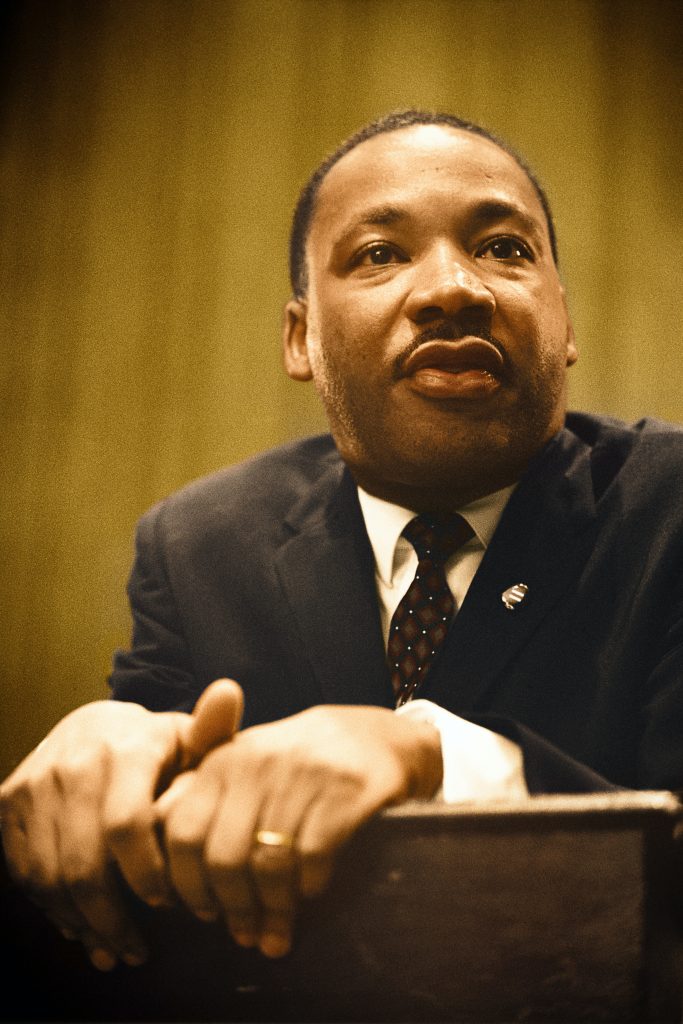Nearly 60 years ago, Dr. Martin Luther King, Jr. delivered an iconic address to a crowd of over 200,000 on the steps of the Lincoln Memorial—more than three times the size of The Beatles’ highest-attended concert and tens of thousands more than Paul McCartney, Tina Turner and Frank Sinatra each drew on their largest world tour stops. The speech, of course, was King’s “I Have a Dream,” one of the most circulated, celebrated and studied orations in modern history.
King, of course, was not a famous rockstar but dedicated much of his life to eradicating the unjust oppression of non-whites in America—the promotion and maintenance of segregation laws, the denial of First Amendment privileges to all, the imposed silence of good people, the church’s sanctioning of human rights as they were, and the widespread misunderstanding of his program of nonviolent, direct action. He saw potential for alchemizing ugliness into justice by dragging the tension of racial discrimination into the open, where it could be seen and contested.
However, many of King’s contemporaries condemned him for radicalized ideas and inciting violence against civil rights demonstrations—the peaceful gatherings, boycotts and sit-ins he inspired and that used bodies as a means of laying his case before America’s conscience. During his lifetime, King became the most hated person in America, was regularly imprisoned for attempting to root out systemic injustice and was assassinated before he could experience the full impact of his determined fight for human rights.
When you consider King’s legacy in this context, it should give you pause—if for no other reason than to gape at the awful majesty of racism both institutionally and in everyday life—because it dispels a romantic notion that he was a widely revered figure in his time. He was, in fact, quite polarizing, which is why the universally moving appeal of King’s communications showcases inimitable feats of rhetoric and the mark of a true thought leader.
Here’s some insight into how King crafted his beautiful, undeniable case for racial equity and the timeless lessons on effective messaging all modern communicators should take from him:
King understood the infrastructure of persuasion
You’ve likely come across the concepts of ethos, pathos and logos at some point in your schooling. It was Aristotle who coined these terms, and they lay the foundation for rhetoric—the art of persuasion. Ethos is used to convince an audience of credibility or authority, pathos is used to elicit an emotional response and logos is an appeal to logic through reason and rationale. The three are closely interrelated, and King knew how to maximize their power to move people to action.
As a Black man in the 50s and 60s, King didn’t have a lot of natural ethos. While he was many things—a minister, a doctoral degree holder, a husband, a father and a philosopher among them—it was difficult to use those identities to his advantage because of the color of his skin. So, he borrowed ethos. In 1963, King orchestrated the March on Washington to gather at the Lincoln Memorial before addressing the crowd. The location was chosen strategically, and King opened his “I Have a Dream” speech by conjuring the memory of respected leaders and the sanctity of American existence—Abraham Lincoln, the founding fathers, the Declaration of Independence and our Constitution. King understood he couldn’t easily gain confidence in his own character, but he could rely on an American conviction in accepted social constructs and leaders.
Here we begin to see how the rhetorical triad is powerfully interwoven. By introducing foundational American archetypes, King moves his audience—which was the entire American public—across the threshold of persuasion onto a platform of established credibility. Now King can leverage what we value (ethos) to affect how we feel (pathos) and what we think (logos). The ethos of the American spirit is fortified by the emotions patriotism stirs, and King carefully selects his words to crystallize that sentiment. He describes Lincoln as a “great American” and the founding fathers as “architects of our republic”; the Emancipation Proclamation is a “momentous decree,” and the Declaration of Independence and Constitution are “magnificent.” His language arouses pride and respect, reminding his audience of the awe and grandeur of the American dream. With emotional buy-in compounding established authority, King can effectively deliver his reasoned argument for America’s “sacred obligation” to guarantee the unalienable rights of life, liberty and the pursuit of happiness to all citizens.
Here’s another example: In his “Letter from a Birmingham Jail,” penned earlier in the same year as the March on Washington, King writes to eight Alabama clergy who publicly critique him, his timing and his civil rights demonstrations. He begins the letter with an appeal to their emotions (pathos), complimenting the men by explaining that while he does not normally respond to his critics, he writes them because he feels they are “men of genuine good will” whose concerns are “sincerely set forth.”
This is an important reminder of the fluidity of the rhetorical triad and the option to generate ethos through pathos and logos. While King’s message is ostensibly for the clergymen, it’s an open letter and meant for the larger population of passive white moderates like them. King’s immediate offer of respect for eight white religious leaders suggests (logos) that he is a rational man of humble character and likely respects the other white faithful (many Americans at the time).
“I want to try to answer your statement in what I hope will be patient and reasonable terms,” King continues, confirming the audience’s sense of his character (ethos) as a level-headed challenger capable of engaging in calm, sensible conversation. Eventually, he uses his constructed ethos to ease the reader into an exercise of deductive reasoning (logos) to determine whether a law is just or unjust and cashes in on the outcome to persuade his audience of the injustice of segregation laws.
King was a master of metaphor and simile
King recognized the utility in metaphors and simile to transcend intellectual roadblocks like ingrained biases, class consciousness and structural inequality. Metaphor is the substitution of one idea for another to draw comparison, while similes liken one thing to another for comparison. In other words, metaphors say one thing is another, while similes say one thing is like another. Both are incredibly effective persuasive tools because they tend to ensure crucial statements elicit real consideration.
One of King’s most memorable similes is his likening of racial discrimination to a subdermal but painful and roiling infection. “Like a boil,” he says in “Letter from a Birmingham Jail,” “[injustice] can never be cured so long as it is covered up but must be opened with all its ugliness to the natural medicines of air and light…to the light of human conscience and the air of national opinion.” It’s an extraordinary comment because of the instant disgust we experience at the thought of a pus-filled, festering skin bump that must rupture to heal—an incredibly effective parallel. King successfully communicates his point that injustice is repulsive and exposing it will be ugly and uncomfortable, but it is the only way it can be resolved.
On a less nauseating note, by far the most common metaphors King uses throughout his work are those of nature and religion. As we are well aware following the last few years of devastating storms across the U.S., we can find distress in nature as often as we find solace. Religious participation was also much more common in the mid-20th century, so he leverages those regularities of human experience to bypass intellectual dams of social bias with resonant, thought-provoking metaphors.
In “I Have a Dream,” King defines the plight of Black Americans as a “sweltering summer” and racial injustice as “quicksand.” He describes the Black American experience as “battered by the storms of persecution” and “staggered by the winds of police brutality.” But, like the weather, he knows things can change. He sees the future of an “invigorating autumn” and of finding footing in the “solid rock” of unity. He believes a “bright day” of justice will emerge from the current inclemency and that America can become “an oasis” of freedom for all. He calls for justice to roll down like water, righteousness to arrive in a mighty stream—metaphors reminiscent of the cleansing waters of the Christian sacrament of baptism. He hopes “one day every valley shall be exalted, every hill and mountain shall be made low, the rough places will be made plain, and the crooked places will be made straight” (lifted directly from the Bible’s Isaiah 40:4) and has “faith” Americans will “hew out of the mountain of despair [this] stone of hope.”
King harnessed the power of other rhetorical devices
It’s easy to spot better-known devices like diction, imagery and personification in King’s work, but he was also a big fan of using two less familiar rhetorical tools that pack a real punch.
First, King’s work is rich with juxtaposition—or placing two things together to create an effect of contrast—to mirror and make apparent what is versus what should be. He pits the “dark valley” of segregation against rising to the “sunlit path” of justice, using the counterparts of darkness and light, depth and height, and indecipherable expanse versus a clear conduit to cast a negative pall around discrimination. Rest and revolt, coolness and heat, wealth and poverty, and dignity and bitterness all feature to highlight the binary of decent and despicable in his core focuses: freedom and oppression, justice and injustice.
Anaphora is probably something you’ve encountered before but just didn’t know it had a name—it’s the repeated use of a word or expression at the beginning of successive phrases, sentences or verses. Anaphora achieves emphasis and stirs up emotion to inspire action, so it’s no wonder King used it frequently. Throughout “I Have a Dream,” King relies on moments of repeated phrases to stress the reality of the times and an urgency for change—“100 years later,” chants the time elapsed since the Emancipation Proclamation had been signed and still unfulfilled; “Now is the time,” emphasizes his imperative to resolve inequity; “We must” precedes specific instructions for change; “Let freedom ring” and “free at last” express his desired outcomes; and most famously, “I have a dream” heralds his hope for a better future:
I have a dream that one day this nation will rise up and live out the true meaning of its creed: We hold these truths to be self-evident, that all men are created equal.
I have a dream that one day on the red hills of Georgia, the sons of former slaves and the sons of former slave owners will be able to sit down together at the table of brotherhood.
I have a dream that one day even the state of Mississippi, a state sweltering with the heat of injustice, sweltering with the heat of oppression will be transformed into an oasis of freedom and justice.
I have a dream that my four little children will one day live in a nation where they will not be judged by the color of their skin but by the content of their character. I have a dream today.
I have a dream that one day down in Alabama with its vicious racists, with its governor having his lips dripping with the words of interposition and nullification, one day right down in Alabama little Black boys and Black girls will be able to join hands with little white boys and white girls as sisters and brothers. I have a dream today.
I have a dream that one day every valley shall be exalted, every hill and mountain shall be made low, the rough places will be made plain, and the crooked places will be made straight, and the glory of the Lord shall be revealed, and all flesh shall see it together.






